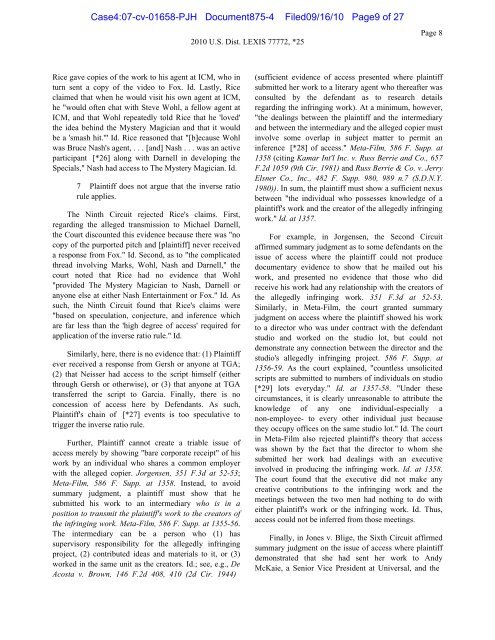exhibit 2 - SAP Lawsuit Portal
exhibit 2 - SAP Lawsuit Portal
exhibit 2 - SAP Lawsuit Portal
You also want an ePaper? Increase the reach of your titles
YUMPU automatically turns print PDFs into web optimized ePapers that Google loves.
Case4:07-cv-01658-PJH Document875-4 Filed09/16/10 Page9 of 27<br />
Rice gave copies of the work to his agent at ICM, who in<br />
turn sent a copy of the video to Fox. Id. Lastly, Rice<br />
claimed that when he would visit his own agent at ICM,<br />
he "would often chat with Steve Wohl, a fellow agent at<br />
ICM, and that Wohl repeatedly told Rice that he 'loved'<br />
the idea behind the Mystery Magician and that it would<br />
be a 'smash hit.'" Id. Rice reasoned that "[b]ecause Wohl<br />
was Bruce Nash's agent, . . . [and] Nash . . . was an active<br />
participant [*26] along with Darnell in developing the<br />
Specials," Nash had access to The Mystery Magician. Id.<br />
7 Plaintiff does not argue that the inverse ratio<br />
rule applies.<br />
The Ninth Circuit rejected Rice's claims. First,<br />
regarding the alleged transmission to Michael Darnell,<br />
the Court discounted this evidence because there was "no<br />
copy of the purported pitch and [plaintiff] never received<br />
a response from Fox." Id. Second, as to "the complicated<br />
thread involving Marks, Wohl, Nash and Darnell," the<br />
court noted that Rice had no evidence that Wohl<br />
"provided The Mystery Magician to Nash, Darnell or<br />
anyone else at either Nash Entertainment or Fox." Id. As<br />
such, the Ninth Circuit found that Rice's claims were<br />
"based on speculation, conjecture, and inference which<br />
are far less than the 'high degree of access' required for<br />
application of the inverse ratio rule." Id.<br />
Similarly, here, there is no evidence that: (1) Plaintiff<br />
ever received a response from Gersh or anyone at TGA;<br />
(2) that Neisser had access to the script himself (either<br />
through Gersh or otherwise), or (3) that anyone at TGA<br />
transferred the script to Garcia. Finally, there is no<br />
concession of access here by Defendants. As such,<br />
Plaintiff's chain of [*27] events is too speculative to<br />
trigger the inverse ratio rule.<br />
Further, Plaintiff cannot create a triable issue of<br />
access merely by showing "bare corporate receipt" of his<br />
work by an individual who shares a common employer<br />
with the alleged copier. Jorgensen, 351 F.3d at 52-53;<br />
Meta-Film, 586 F. Supp. at 1358. Instead, to avoid<br />
summary judgment, a plaintiff must show that he<br />
submitted his work to an intermediary who is in a<br />
position to transmit the plaintiff's work to the creators of<br />
the infringing work. Meta-Film, 586 F. Supp. at 1355-56.<br />
The intermediary can be a person who (1) has<br />
supervisory responsibility for the allegedly infringing<br />
project, (2) contributed ideas and materials to it, or (3)<br />
worked in the same unit as the creators. Id.; see, e.g., De<br />
Acosta v. Brown, 146 F.2d 408, 410 (2d Cir. 1944)<br />
2010 U.S. Dist. LEXIS 77772, *25<br />
Page 8<br />
(sufficient evidence of access presented where plaintiff<br />
submitted her work to a literary agent who thereafter was<br />
consulted by the defendant as to research details<br />
regarding the infringing work). At a minimum, however,<br />
"the dealings between the plaintiff and the intermediary<br />
and between the intermediary and the alleged copier must<br />
involve some overlap in subject matter to permit an<br />
inference [*28] of access." Meta-Film, 586 F. Supp. at<br />
1358 (citing Kamar Int'l Inc. v. Russ Berrie and Co., 657<br />
F.2d 1059 (9th Cir. 1981) and Russ Berrie & Co. v. Jerry<br />
Elsner Co., Inc., 482 F. Supp. 980, 989 n.7 (S.D.N.Y.<br />
1980)). In sum, the plaintiff must show a sufficient nexus<br />
between "the individual who possesses knowledge of a<br />
plaintiff's work and the creator of the allegedly infringing<br />
work." Id. at 1357.<br />
For example, in Jorgensen, the Second Circuit<br />
affirmed summary judgment as to some defendants on the<br />
issue of access where the plaintiff could not produce<br />
documentary evidence to show that he mailed out his<br />
work, and presented no evidence that those who did<br />
receive his work had any relationship with the creators of<br />
the allegedly infringing work. 351 F.3d at 52-53.<br />
Similarly, in Meta-Film, the court granted summary<br />
judgment on access where the plaintiff showed his work<br />
to a director who was under contract with the defendant<br />
studio and worked on the studio lot, but could not<br />
demonstrate any connection between the director and the<br />
studio's allegedly infringing project. 586 F. Supp. at<br />
1356-59. As the court explained, "countless unsolicited<br />
scripts are submitted to numbers of individuals on studio<br />
[*29] lots everyday." Id. at 1357-58. "Under these<br />
circumstances, it is clearly unreasonable to attribute the<br />
knowledge of any one individual-especially a<br />
non-employee- to every other individual just because<br />
they occupy offices on the same studio lot." Id. The court<br />
in Meta-Film also rejected plaintiff's theory that access<br />
was shown by the fact that the director to whom she<br />
submitted her work had dealings with an executive<br />
involved in producing the infringing work. Id. at 1358.<br />
The court found that the executive did not make any<br />
creative contributions to the infringing work and the<br />
meetings between the two men had nothing to do with<br />
either plaintiff's work or the infringing work. Id. Thus,<br />
access could not be inferred from those meetings.<br />
Finally, in Jones v. Blige, the Sixth Circuit affirmed<br />
summary judgment on the issue of access where plaintiff<br />
demonstrated that she had sent her work to Andy<br />
McKaie, a Senior Vice President at Universal, and the


